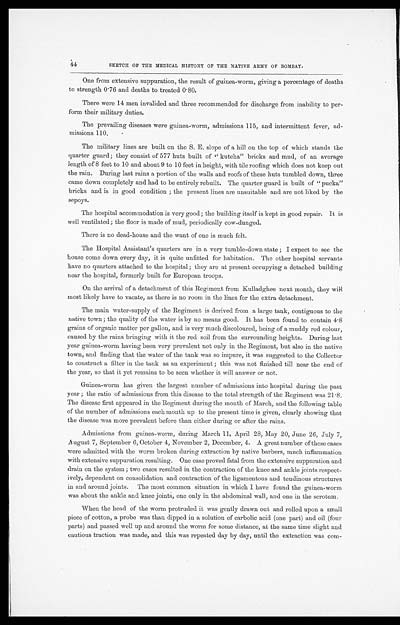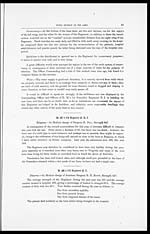Medicine - Institutions > Army health reports and medical documents > Sketch of the medical history of the native army of Bombay > Sketch of the medical history of the native army of Bombay, for the year 1870
(117) Page 44
Download files
Individual page:
Thumbnail gallery: Grid view | List view

44
SKETCH OF THE MEDICAL HISTORY OF THE NATIVE ARMY OF BOMBAY.
One from extensive suppuration, the result of guinea-worm, giving a percentage of deaths
to strength 0.76 and deaths to treated 0.80.
There were 14 men invalided and three recommended for discharge from inability to per-
form their military duties.
The prevailing diseases were guinea-worm, admissions 115, and intermittent fever, ad-
missions 110.
The military lines are built on the S. E. slope of a hill on the top of which stands the
quarter guard; they consist of 577 huts built of "kutcha" bricks and mud, of an average
length of 8 feet to 10 and about 9 to 10 feet in height, with tile roofing which does not keep out
the rain. During last rains a portion of the walls and roofs of these huts tumbled down, three
came down completely and had to be entirely rebuilt. The quarter guard is built of "pucka"
bricks and is in good condition; the present lines are unsuitable and are not liked by the
sepoys.
The hospital accommodation is very good; the building itself is kept in good repair. It is
well ventilated; the floor is made of mud, periodically cow-dunged.
There is no dead-house and the want of one is much felt.
The Hospital Assistant's quarters are in a very tumble-down state; I expect to see the
house come down every day, it is quite unfitted for habitation. The other hospital servants
have no quarters attached to the hospital; they are at present occupying a detached building
near the hospital, formerly built for European troops.
On the arrival of a detachment of this Regiment from Kulladghee next month, they will
most likely have to vacate, as there is no room in the lines for the extra detachment.
The main water-supply of the Regiment is derived from a large tank, contiguous to the
native town; the quality of the water is by no means good. It has been found to contain 4.8
grains of organic matter per gallon, and is very much discoloured, being of a muddy red colour,
caused by the rains bringing with it the red soil from the surrounding heights. During last
year guinea-worm having been very prevalent not only in the Regiment, but also in the native
town, and finding that the water of the tank was so impure, it was suggested to the Collector
to construct a filter in the tank as an experiment; this was not finished till near the end of
the year, so that it yet remains to be seen whether it will answer or not.
Guinea-worm has given the largest number of admissions into hospital during the past
year; the ratio of admissions from this disease to the total strength of the Regiment was 21.8.
The disease first appeared in the Regiment during the month of March, and the following table
of the number of admissions each month up to the present time is given, clearly showing that
the disease was more prevalent before than either during or after the rains.
Admissions from guinea-worm, during March 11, April 28, May 20, June 26, July 7,
August 7, September 6, October 4, November 2, December, 4. A great number of these cases
were admitted with the worm broken during extraction by native barbers, much inflammation
with extensive suppuration resulting. One case proved fatal from the extensive suppuration and
drain on the system; two cases resulted in the contraction of the knee and ankle joints respect-
ively, dependent on consolidation and contraction of the ligamentous and tendinous structures
in and around joints. The most common situation in which I have found the guinea-worm
was about the ankle and knee joints, one only in the abdominal wall, and one in the scrotum.
When the head of the worm protruded it was gently drawn out and rolled upon a small
piece of cotton, a probe was than dipped in a solution of carbolic acid (one part) and oil (four
parts) and passed well up and around the worm for some distance, at the same time slight and
cautious traction was made, and this was repeated day by day, until the extraction was com-
Set display mode to: Large image | Zoom image | Transcription
Images and transcriptions on this page, including medium image downloads, may be used under the Creative Commons Attribution 4.0 International Licence unless otherwise stated. ![]()
| Permanent URL | https://digital.nls.uk/75007089 |
|---|




